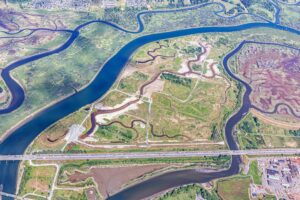Word in from the Port of Everett that the their Blue Heron Slough Wetland Restoration Project has reached its last phase. Here’s the update.

The project restores 353 acres of Snohomish River estuary habitat between the cities of Everett and Marysville. Photo Port of Everett.
The site is now being returned to its former natural condition as estuarine habitat benefiting all estuary-dependent species, and in particular, native salmon species and bull trout. The benefits to Chinook salmon will aid in the recovery of the species, which is expected, in turn, to benefit the southern resident orcas of Puget Sound.
The final phase of restoration began earlier this month as Wildlands and contractor Dungeness coordinated a controlled breach process to remove sections of the old agricultural dike from North Spencer Island, which had been diked and drained for agriculture in the early 1900s, to allow for the return of Snohomish River water and restore a significant portion of the estuary.
Two of the four planned dike sections have been breached, with the remaining two to take place over the next few weeks during low tides. Water flows into the site with each successive breach and is currently flowing in and out of the site during the tide cycles. Earthwork is expected to be completed in October.
The Port and project partners will gather on site later this week to celebrate the restoration.
“The Blue Heron Slough has been over 30 years in the making,” Port of Everett Commission President David Simpson said. “Port leadership saw the property’s potential to restore the land in the ‘90s. I want to thank Port leadership and all commissioners, past and present, who have worked over the decades to make sure this estuary project, so important to our salmon populations and the resident orca that feed on them, was realized.”
Blue Heron Slough was already home to numerous wildlife species including deer, coyote, frogs, ducks, geese, swan and many other resident and migratory birds including its namesake, great blue heron. In response to the newly re-connected estuary habitat, salmon, bull trout, and other estuary-dependent species are expected to immediately return to the site.
Wildlands, the Port’s partner in the project, designed and permitted the restoration project and then retained Dungeness to implement the design which includes a mosaic of meandering channels, marshes, mudflats, and riparian areas reconnected to river and tidal influences.
“Blue Heron Slough is a legacy project for all who have worked for decades to see it through to completion,” said Mark Heintz, CEO of Wildlands. “It is breathtaking to witness the result of decades of work culminate in the return of tidal waters, and with it the return of salmon and bull trout, to this once degraded land. It will be a privilege to watch as the habitat develops, and fish and wildlife return to their new permanently protected habitat.”
The Port acquired the land now known as Blue Heron Slough, a property on north Spencer Island, in 1993. The 2005 Snohomish River Basin Salmon Conservation Plan identifies the Blue Heron Slough as key to salmon recovery, which will also benefit resident orcas in Puget Sound.
In 2019, the Port came to an agreement with the Port Gardner Bay Trustees to construct the project. The Port Gardner Bay Trustees are comprised of the Tulalip Tribes, Suquamish Tribe, U.S. Department of Interior, U.S. Fish and Wildlife Service, U.S. Department of Commerce, National Oceanic and Atmospheric Administration, and the Washington State Department of Ecology. A portion of the site was dedicated to the agreement with the Trustees through a Consent Decree.
Blue Heron Slough is under a conservation easement held by the Tulalip Tribes, which will protect this land for conservation purposes in perpetuity. The estuary is a NOAA certified environmental conservation credit bank, and has a pending wetland bank accreditation (approval expected in 2023). The Blue Heron Slough Project aims to create a balance between our region’s economic development, while increasing the health of critically important wetland and wildlife habitat to provide benefits now and for future generations.




August 29, 2022
Everett